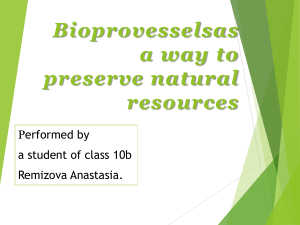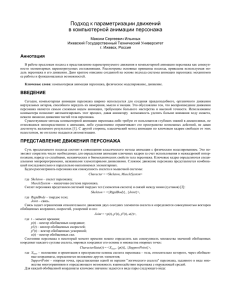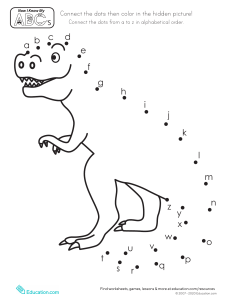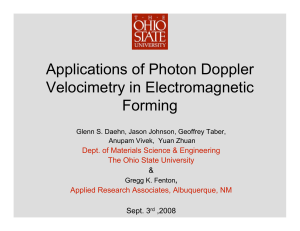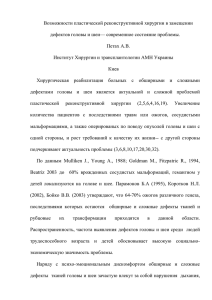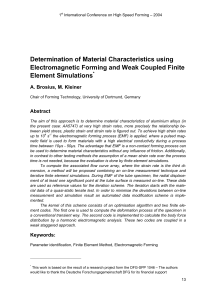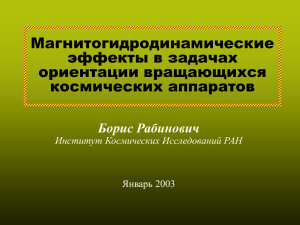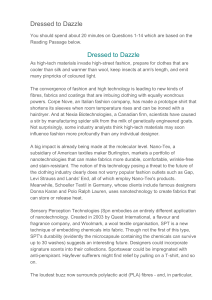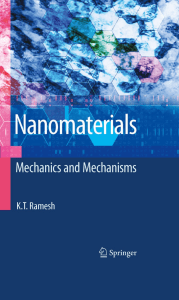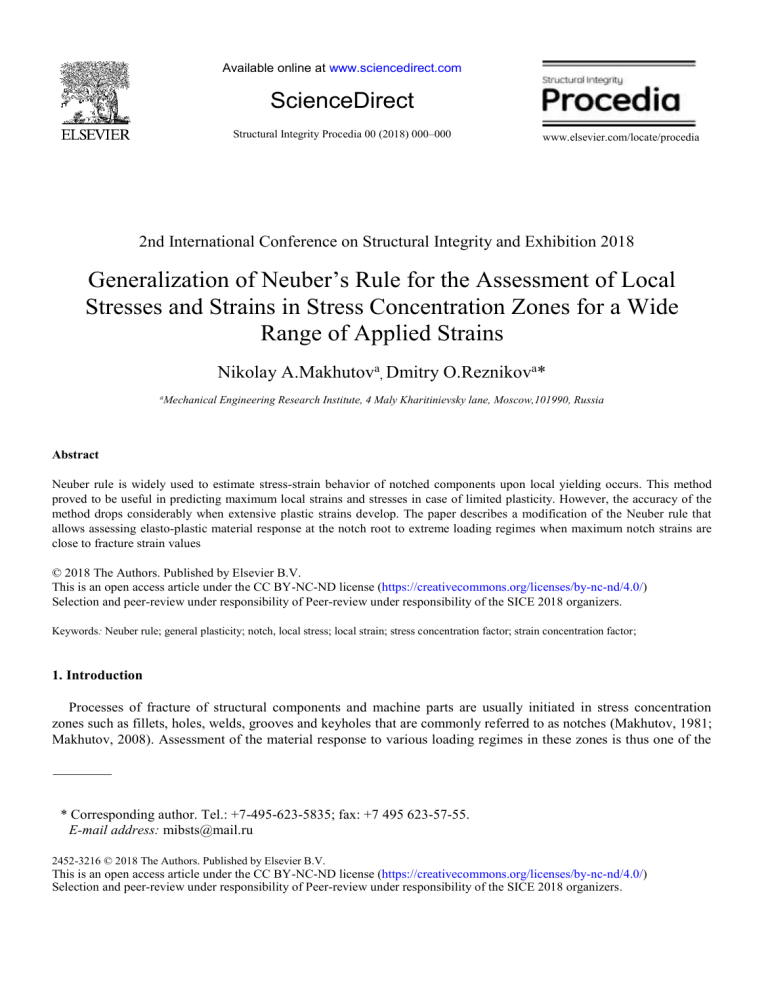
Available online at www.sciencedirect.com ScienceDirect Structural Integrity Procedia 00 (2018) 000–000 www.elsevier.com/locate/procedia 2nd International Conference on Structural Integrity and Exhibition 2018 Generalization of Neuber’s Rule for the Assessment of Local Stresses and Strains in Stress Concentration Zones for a Wide Range of Applied Strains Nikolay A.Makhutova, Dmitry O.Reznikova* a Mechanical Engineering Research Institute, 4 Maly Kharitinievsky lane, Moscow,101990, Russia Abstract Neuber rule is widely used to estimate stress-strain behavior of notched components upon local yielding occurs. This method proved to be useful in predicting maximum local strains and stresses in case of limited plasticity. However, the accuracy of the method drops considerably when extensive plastic strains develop. The paper describes a modification of the Neuber rule that allows assessing elasto-plastic material response at the notch root to extreme loading regimes when maximum notch strains are close to fracture strain values © 2018 The Authors. Published by Elsevier B.V. This is an open access article under the CC BY-NC-ND license (https://creativecommons.org/licenses/by-nc-nd/4.0/) Selection and peer-review under responsibility of Peer-review under responsibility of the SICE 2018 organizers. Keywords: Neuber rule; general plasticity; notch, local stress; local strain; stress concentration factor; strain concentration factor; 1. Introduction Processes of fracture of structural components and machine parts are usually initiated in stress concentration zones such as fillets, holes, welds, grooves and keyholes that are commonly referred to as notches (Makhutov, 1981; Makhutov, 2008). Assessment of the material response to various loading regimes in these zones is thus one of the * Corresponding author. Tel.: +7-495-623-5835; fax: +7 495 623-57-55. E-mail address: [email protected] 2452-3216 © 2018 The Authors. Published by Elsevier B.V. This is an open access article under the CC BY-NC-ND license (https://creativecommons.org/licenses/by-nc-nd/4.0/) Selection and peer-review under responsibility of Peer-review under responsibility of the SICE 2018 organizers. 2 N.Makhutov et al./Procedia Structural Integrity 00 (2018) 000–000 key problems in ensuring structural integrity and safety. Such assessment should be carried out not only for the cases of normal loading regimes that cause elastic (ε<εY) and limited elasto-plastic (ε<εlp=5εY) response of the material in the notch zone (regions I and II of the stress-strain curve, fig.1), but also for the cases of extreme loading that causes extensive plastic strains and general yielding of the cross section (region III fig.1 when maximum local strains tend to fracture values that can reach up to εf ~5070% or 20εY). This will allow one to estimate residual strength and remaining lifetime of highly damaged structures. Nomenclature E - elasticity modulus ES - secant modulus at the notch root F – correction function in generalized Neuber rule Kε –strain concentration factor Kσ – stress concentration factor Kt – theoretical (elastic) stress concentration factor m –strain hardening exponent Wn - energy density due to nominal stress and strain Wε strain energy orm at the notch root εf – fracture strain εlp– limited plastic strain εn – nominal strain εmax k - maxim local strain at the notch root εe-f -pseudoelastic (fictitious) strains at the notch root εp-f - pseudoplastic (fictitious plastic) strains at the notch root εY – yield strain σmax k - maxim local stress at the notch root (maximum notch stress) σe-f - pseudoelastic (fictitious elastic) stresses at the notch root σp-f - pseudoplastic (fictitious plastic) stresses at the notch root σn – nominal stress σnnorm - nominal stress due to normal loading σnextr -nominal stress due to extreme loading σY – yield stress Φ – transformation that maps pseudoelastic or pseudoplastic states to actual stress-strain states at the notch zone ΦN – Neuber transformation ΦM –Makhutov transformation The accumulation of strain in post-yielding situation is a complicated task. Closed form solutions are only available for a relatively small number of specific cases. Three types of approaches are used in notch mechanics: experimental strain measurements, numerical simulations (FEM), and approximate analytical methods also known as stress-strain conversion rules. Neuber rule is a widely used as an approximate analytical method for estimation of the stress-strain behavior of notched components upon local yielding occurs (Neuber,1961). This method tends to overestimate local strains, but proved to be useful in predicting maximum local strains and stresses in case of limited plasticity when the extent of the plastic zone around the notch tip is small in comparison with the elastic area surrounding the plastic zone (about 0.1 - 0.2 of the elastic area width surrounding the notch tip). However, the accuracy of the method drops considerably when extensive plastic strains develop. The paper describes a modification of the Neuber rule that allows one to assess elasto-plastic material response at the notch root to extreme loading regimes when maximum notch strains are close to fracture strain values and general yielding over the entire cross section occurs (Makhutov, 1981; Makhutov, 2008). Author name / Structural Integrity Procedia 00 (2018) 000–000 3 2. Key concepts and methods used in notch mechanics Until material at the notch root remains elastic, theoretical stress concentration factor Kt relates nominal stresses σn and strains εn to the maximum local values σmaxk and εmaxk at the notch root (Bannantine et al, 1990;. Manson and Halford, 2006): max k Kt n , (1) max k Kt n . Fig.2. Relationship between Kt, Kσ, Kε Fig.1. Stress strain conversion rules for different strain ranges 1 – Stress-strain curve, 2 –Pseudoelastic states; 3 –Pseudoplastic states; ΦN is a Neuber’s mapping according to (14) ΦM is a Makhutov mapping according to (20); I – range of elastic strains; II – range of limited plastic strains; III – range of extensive plastic strains Values of Kt for a variety of notched components are readily available and particularly useful for brittle materials in order to predict the peak stresses. For increasing nominal stresses Kt remains constant until yielding begins. For ductile materials, the local region of high stress is relieved as yielding occurs and the maximum stress is no longer equal to Kt multiplied by the nominal stress. Upon yielding, local stresses and local strains are no longer linearly dependent. A power law approximation of strain hardening can be used to describe stress-strain relationship in plastic region: m max k K max k, (2) where K and m are material constants. After yielding occurs, local values of stresses and strains are no longer related to the nominal values by Kt. In plastic region nominal and local values of stresses and strains are related in terms of stress and strain concentration factors: 4 N.Makhutov et al./Procedia Structural Integrity 00 (2018) 000–000 K max k / n K max k / n for max k Y . (3) Besides, in the plastic region local stress concentration factor Kσ decreases with respect to Kt and local strain concentration factor Kε increases as well (fig.2). For power law approximation of the stress-strain curve the following relation between maximum local stress and strain can be written: max k E max k for max k Y max k Y ( max k / Y )m max k Y . for (4) (5) Similar expressions can be written for nominal stresses and strains that describe the cases of nominally elastic and plastic behavior of the structural component: n E n for n Y n Y ( n / Y )m for n Y . (6) (7) The rearrangement of equations (5) and (7) gives the expression between Kσ and Kε. m K K n Y for Y n m n Y , max Y . (8) The concepts of pseudoelastic (fictitious) stress σe-f and strain εe-f fields are used in notch mechanics. They are calculated using methods of linear elasticity theory in the assumption that material at the notch zone deforms elastically when maximum local stresses accede to yield strength value: e f Kt n e f Kt n , for n Y . (9) Similar concepts of pseudoplastic (fictitious) stresses σp-f and strain εp-f may also be introduced for approximation of notch stresses and strains when nominally plastic behavior according equation (7) is assumed: p f Kt n p f K t n , for n Y . (10) Approximate analytical methods for assessment of stress-strain response in the notch zone are based on the following two types of equations: 1) Constitutive laws that relate maximum local stresses and strains in the stress concentration zone in the plastic region. For the case of monotonic loading a Ramberg-Osgud relation might be used: max k max k E max k K 1/ m . (11) 2) Postulated expression (mapping, transformation) Φ that relates the values of elastic pseudo stresses and strains (σe-f ; εe-f) that are calculated by elasticity theory in the assumption that material in the notch zone is deformed Author name / Structural Integrity Procedia 00 (2018) 000–000 5 elastically, and the actual elasto-plastic response of the material at the notch tip (σmax k; εmax k): { max k , max k } { e f , e f } for e f Y , e f Y . (12) The transformation Φ in essence determines the mapping of points Ae-f (σe-f; εe-f) of the semiaxis CE∞ of the fictitious elastic pseudo states of the material to points Amax k(σmax k;εmax k) of the segment CP∞ of the stress-strain curve (Makhutov and Reznikov, 2018): Ae f ( e f , e f ) Amax k ( max k , max k ) for e f Y , e f Y . (13) A number of approximate analytical methods of that kind (which are commonly known as stress-strain conversion rules) were developed and are widely applied along with numerical and experimental ones. These include: 1) Linear rule that is based on the assumption that strain concentration factor is equal to theoretical stress concentration factor : K K t . (14) 2) Neuber rule that relates stress and strain concentration factors (Kσ and Kε) to the theoretical stress concentration factor Kt: K K / K t2 1 , (15) 3) Molski and Glinka or (Equivalent Strain Energy Density) method which assumes that the strain energy density in the notch root Wε is related to the energy density due to nominal stress and strain Wn by a factor of Kt2 (Molski and Glinka,1981). W Kt2Wn . (16) 4) Hardrath and Ohman method that expresses stress concentration factor Kσ as a function of theoretical stress concentration factor Kt , elasticity modulus E and secant modulus at the notch root ES: K 1 ( Kt 1) ES / E . (17) Many experimental and numerical investigations have been carried out in order to verify these rules. Results show that Neuber rule predicts an upper bound on maximum local strains, linear rule provides a lower bound and the Equivalent Strain Energy Density method estimates will lie between the two bounds (Adibi-Asl, 2009). 3. Modifications of Neuber rule Neuber rule proved to be the most convenient and widely used approximate analytical method allowing determination of the stress-strain material response at the notch zone in elastoplastic formulation. It tends to overestimate local strains, but provides adequate assessments of the maximum local stresses and strains for the range of limited plastic strains (range II, fig. 1) that correspond to normal loading regimes. However the accuracy of estimates obtained using equation (15) decreases dramatically as soon as applied strains move to the range III that corresponds to accident and catastrophic loading regimes. Seeger and Heuler proposed a generalized version of Neuber rule allowing local assessment of the material stress-strain response at the notch region for the case of 6 N.Makhutov et al./Procedia Structural Integrity 00 (2018) 000–000 extreme loading that is based on introduction of modified nominal stresses σ n,M to account for general yielding of the notched cross-section (Seeger and Heuler, 1980). N.Makhutov in (Makhutov, 1981) proposed a different approach to assessment of material response under the extreme loading regimes that cause extensive plastic deformation and general yielding of the structural component cross section. On the basis of generalization of available numerical and analytical solutions as well as the estimation of a huge volume of experimental data a modification of Neuber rule was developed in which a correction function F(Kt,σn,σ(ε)) was introduced into Neuber equation (15). This function allows accounting for the dependence of stress Kσ and strain Kε concentration factors from theoretical stress concentration factor Kt, nominal stresses σn and strain hardening exponent m: K K F ( K t , n , ( )) . K t2 (18) Assessing the experiment results and available closed form and numerical solutions one may come to the conclusion that the correction function F should have the following properties: 1) When the material response is elastic (Kσ=Kε=Kt), the values of F should be equal to 1; 2) Due to the changes of the geometry of the notch as the values of elasto-plastic strains increase the values of the function F should decrease to a certain minimum value that corresponds to the moment of loss of stability in the process of plastic deformation in the notch zone. 3) As plastic strains increase after the loss of stability of plastic deformation in the notch zone and the area of the cross section decrease the values of the function F should rise. The following phenomenological function was proposed that satisfies these three requirements and fits well to available experiment data in a wide range of applied strains: F ( Kt , n , ( )) Y / Kt n 0.5(1m ) 1 n Y 1 Kt , (19) Substituting equation (18) into equation (17) gives: K K Kt2 Y / Kt n 0.5(1m ) 1 n Y 1 Kt . (20) Taking into account equations (1) and (14), equation (20) may be rewritten in the form of transformation Φ M that carries out a mapping of the curve of pseudoplastic states Aextr(σp-f;εp-f) to the actual notch states Amax(σmaxk; εmaxk) located on the stress-strain curve 1 (fig.1). Here instead of pseudoelastic states Anorm(σe-f; εe-f) located on semiaxis 2 whose coordinates are determined by equations (6) and (9) in the assumption of nominally elastic behavior, the so-called pseudoplastic states Aextr(σp-f; εp-f) of the curve 3 whose coordinates are determined by equations (7) and (10) in the assumption of nominally plastic material response are used as preimage points of the transformation. This transformation characterizes redistribution of stresses and strains at the notch zone in the process of plastic deformation: max k max k p f p f Y p f 0.5(1m ) 1 n Y n p f . (21) Thus, transformation ΦM is analogous to Neuber transformation ΦN. It maps the points Aextr(σp-f; εp-f) of the curve of pseudoplastic states to the points Amax(σmax k; εmax k) of the stress-strain curve. But in contrast to transformation ΦN the proposed transformation ΦM allows accounting the values of theoretical stress concentration factors Kt, nominal stresses σn, and power hardening exponent m. Thus, determining the relationship between fictitious pseudoplastic states (σp-f; εp-f) and maximum local stress and strains (σmax k, εmax k) at the notch zone for the wide Author name / Structural Integrity Procedia 00 (2018) 000–000 7 range of nominal stresses σn. Rearranging equations (4-8) and (20) gives the following expression for stress and strains concentration factors: K K K K K t2/(1 m ) n Y 0.5(1 m )[1( Kt Y n (1 m )/(1 m) n Y 1 Kt )] (1 m ) n Y 1 Kt )] (1 m ) Kt2/(1m ) 0.5(1m )[1( Kt Y n Kt2 m/(1m ) (1m )/(1 m) 0.5(1m )[1( n Y Kt Y n Kt2 m/(1m ) 0.5(1m )[1( Kt Y n n Y 1 Kt )] (1 m ) n for n Y ; (22) for n Y ; (23) Y 1 Kt )] (1 m ) for for n Y ; n Y . (24) (25) Fig. 3 Functional relationship F(χ) 1- Line F(χ)≡1 according to Neuber rule (15) .2,3 – Relationships F(χ) according to equation (19) Fig.3 demonstrates the dependence of the function F defined by the equation (19) on the parameter χ=Ktσn/σY. Points denote results of experiments for the notched specimens with theoretical stress concentration factors that vary within the range Kt=2.2–96 made of reactor steel 15Х2МFА (Makhutov, 1981). The stress-strain curve was approximated by power hardening law with exponent m=0.08. Nominal stresses are in the range σn=0.5σY–0.55σY. It is important to note that for all the values of parameter χ=Ktσn/σY>1 the experimentally obtained values of the function F differ from the value F=1 which is determined by Neuber rule according to equation (15). This fugue shows that the proposed model allows predicting plastic behavior of the material at the roots of notches under monotonic loading in a wide range of plastic deformations. 8 N.Makhutov et al./Procedia Structural Integrity 00 (2018) 000–000 Fig. 4. Theoretical and experimental local strains for smooth (Kt=5,1) and notched (Kt=1,5 - 5,1) specimens Fig. 4 presents plots of the maximum logarithmic strains at the notch root against net nominal stresses for smooth (Kt=1) and notched specimens (Kt>1) made of austenite heat-resistant steel 80Х18Н10Т. The experimental data are depicted by the points. Results of calculation according to equations (22) and (23) are shown by solid lines. These calculations were carried out with accounting for the 8-18% increase of the resistance to plastic deformation due to triaxial stress state in the notch zone. This figure demonstrates a good agreement between results of calculations according to equations (22) -(23) and experimental results for a wide range of strains (regions II and III). Several different materials, notch geometries and types of loading have been considered and similar agreement between theory and experiment was achieved. 4. Conclusions The proposed phenomenological model fits well to available experiment data on stress-strain response of material at the notch root in the wide range of plastic strains. It allows describing the performance of the notched components not only under normal loading regimes but also to predict its behavior when it is subjected to extreme loads. The presented approach provides the opportunity to assess residual strength and remaining lifetime of highly damaged structures. Acknowledgments This work is financially supported by the Russian Foundation for Basic Research (grant 16-58-48008 IND_omi). References Adibi-Asl R., Seshadri R. 2009. Improved Prediction Method for Estimating Notch Elastic-Plastic Strain. Journal of Pressure Vessel Technology. 135(4):041203-041203-9. Bannantine J., Comer J, Handrock J. 1990. Fundamentals of metal fatigue analysis. Prentice Ney Jersey. Hall edition, pp. 271. Hoffmann M., Seeger T. 1985. Generalized Method for Estimating Multiaxial Elastic–Plastic Notch Stresses and Strains, Part 1: Theory,” Trans. ASME, Journal of Engineering Materials and Technology,. 107. 250– 254. Klesnil M., Lukas P. 1992. Fatigue of Metallic Materials. Materials Science Monographs.Volume 71. Elsevier. pp.270 Manson S., Halford G. 2006. Fatigue and Durability of Structural Materials. USA. ASM International., pp. 455 Makhutov N. 1981. Strain-based Fracture Criteria and Structural Strength Design. Mashinostroeniye publ, Moscow, pp. 271 (in Russian). Makhutov N. 2008. Strength and Safety. Basic and Applied Research. Nauka publ. Novisibirsk. pp 528 (in Russian). Makhutov N., Reznikov D. 2018. Methods for Assessment of Stress-Strain States in Stress Concentration Zones in Regular and Accident Loading Conditions. Problems of Safety and Emergency Situations. 4, 3-28 (in Russian) Molski K., Glinka G. 1981. A method of elastic–plastic stress and strain calculation at a notch root. Material Science and Engineering;50:93–100. Neuber, H., 1961. Theory of stress concentration for shear-strained prismatical bodies with arbitrary nonlinear stress–strain law. Journal of Applied Mechanics. 28, 544–550 Seeger T, Heuler P. 1980, Generalized application of Neuber’s rule. Journal of Testing and Evaluation;8.199–204. Stephens R.I., Fatemi, A., Stephens, R.R., Fuchs, H. 2000. Metal Fatigue in Engineering,” John Wiley, New York. pp.472

